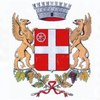Calosso
Calosso | |
|---|---|
| Comune di Calosso | |
 | |
| Coordinates: 44°44′N 8°14′E / 44.733°N 8.233°E | |
| Country | Italy |
| Region | Piedmont |
| Province | Province of Asti (AT) |
| Frazioni | frazione Castagna, frazione Piana del Salto, frazione Mosiano, regione Rodotiglia, regione San Bovo, regione Soria [1] |
| Government | |
| • Mayor | Migliardi Pier Francesco (elected 26 maggio 2019> (Vivere e Migliorare Insieme) |
| Area | |
| • Total | 15.7 km2 (6.1 sq mi) |
| Elevation | 235 m (771 ft) |
| Highest elevation | 399 m (1,309 ft) |
| Lowest elevation | 155 m (509 ft) |
| Population (Jan. 2024)[3] | |
| • Total | 1,112 |
| • Density | 71/km2 (180/sq mi) |
| Demonym | Calossesi |
| Time zone | UTC+1 (CET) |
| • Summer (DST) | UTC+2 (CEST) |
| Postal code | 14052 |
| Dialing code | 0141 |
| ISTAT code | 005015 |
| Patron saint | Beato Alessandro Sauli |
| Saint day | 11 October |
| Website | Official website |
Calosso is a rural comune (municipality) in the Province of Asti in the Italian region Piedmont, located about 60 kilometres (37 mi) southeast of Turin and about 20 kilometres (12 mi) south of Asti in the hilly area between the Tanaro and Belbo and on the borders between Monferrato and Langa. As of 31 January 2024, it had a population of 1,112 and an area of 15.7 square kilometres (6.1 sq mi).[4]
The comune borders the following municipalities: Agliano Terme, Canelli, Castiglione Tinella, Costigliole d'Asti, Moasca, and Santo Stefano Belbo.
The village itself, together with its castle, stands on a hill surrounded by the vineyards which represent its principal economic activity.
History[edit]
The first document in which the town is mentioned is an act from 960 which cites a certain Arimanno de Calocio as a witness to an exchange of land by Brunengo, Bishop of Asti between 934 and 964. At the beginning of the 12th century Calosso became part of the consortium of Acquosana together with the lords of Agliano, Vinchio, Canelli, San Marzano and Castelnuovo Calcea. Consortium created to protect the minor fiefdoms from the expansionist aims of the abstention families (such as the Asinari, the Roero, the Solaro, the Natta etc.).
In 1318 the municipality was involved in the phases of the civil war that broke out in the Asti district between the Solaro Guelphs and the De Castello Ghibellines. The Guelphs, in addition to the castle of Moasca, also destroyed the castrum of Calosso which was immediately rebuilt. Towards the end of the independence of the Free Municipality of Asti and precisely in 1377, the entire fiefdom of Calosso was purchased by the noble banker from Asti Percivalle Roero. Ten years later, in 1387, we find Calosso among the possessions of the dowry of Valentina Visconti, who married Louis of Orléans. Following the marriage, the county of Asti becomes entirely a French possession. One hundred and fifty years of French domination will follow. In 1531 Calosso, with the County of Asti, became part of the territories controlled by the Savoys and with the beginning of the VII century and the War of the Monferrato Succession, it was involved in an endless series of occupations by the various passing armies. In fact, at the beginning of the 17th century, Calosso was besieged by the Spanish and later recovered by the Savoys, thanks also to Captain Catalano Alfieri who, at the head of the French troops, had the entire castle surrounded by enormous palisades.
Fortunately, with the Peace of the Pyrenees in 1659, Calosso lost its strategic importance and its castle, from an imposing sixteenth-century fortress, was transformed into a country residence of the Roero family
Local government[edit]
The comune belongs to the Comunità delle colline tra Langa e Monferrato.
Viticulture[edit]
Around two thirds of the area of the commune, and by far the greatest part of its agricultural land is devoted to vineyards. Production is on a small scale: this 10 square kilometres (4 sq mi) or so is divided between 380 farms and the total annual production of wine is around 4,900,000 litres (1,300,000 US gal).
The principal grape variety grown here is the Moscato Bianco, while others include Barbera, Dolcetto, Nebbiolo, Chardonnay and Freisa. Of particular interest is the cultivation of the now rare historical variety Gamba di Pernice (literally ‘Pheasant’s leg’).[5]
Demographic evolution[edit]

References[edit]
- ^ Comune di Calosso (AT) - Italia: Informazioni
- ^ "Superficie di Comuni Province e Regioni italiane al 9 ottobre 2011". Italian National Institute of Statistics. Retrieved 16 March 2019.
- ^ "Popolazione Residente al 1° Gennaio 2018". Italian National Institute of Statistics. Retrieved 16 March 2019.
- ^ All demographics and other statistics: Italian statistical institute Istat.
- ^ "Comune di Calloso :: Vignetti". Archived from the original on 2006-05-06. Retrieved 2006-09-21.




